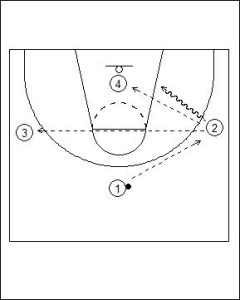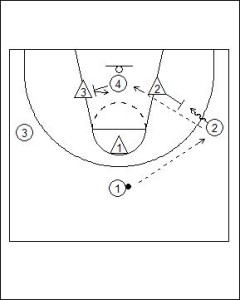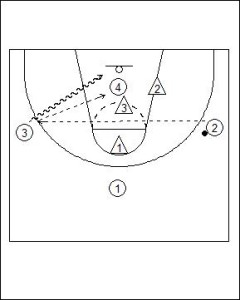4 vs. 3 Fast Break Options
The 4 vs. 3 Fast Break options are the final stage of development for a team to examine when they decide to explore scoring principles within the first phase of their offense. Anything above a four person fast break should lead not into instinctive fast break situation which allows for more fluid reads, but structured offense in the form of a team’s primary or secondary transition.
The philosophy changes with the 4 vs. 3 fast break to that highlighted in the 2 vs.1 or 3 vs. 2 to add the additional element of an interior target. This is because due to the number of offensive players the core focus of spreading the ball changes to creating depth, not just width in the scoring opportunities.
The core principles of the 4 vs. 3 fast break options are:
- Create strong side advantage in the driving lane
- Interior player making a big target for second scoring option
- Ball is skipped to weak side for offensive option.
By creating strong side advantage in the driving lane the defence is forced to engage and rotate to contain the possible scoring options. All too often in fast break situations the offense will take the first presented shooting opportunity rather than working to secure the best possible option. In essence this point focusses on either making the defence defend the dribbler or a lay-up being the resulting scoring option of choice.
The next highlighted scoring opportunity is centred on the interior player making a big target. When all possible scoring options are examined the interior target will provide the highest possible chance of a high percentage scoring opportunity. Initially the interior target must find their position on the front of the basket so they pull the defence down into the keyway. This will increase the distance for close-outs to the wing players allowing for additional time to help make the right choice by the offense. Secondly the interior player can react once the pass has been initiated more effectively from this point on the front of the basket.
If neither the driving lane nor interior target option presents itself the ball is skipped to the weak side for the offensive option to be again explored. In this situation depending on the options presented by the defence the same options explore on the initial side of the floor will be again attempted from the ball reversal.

The 4 vs. 3 fast break option should be the focus of any broken play opportunity.
The first “Big” across halfway (Four) sprints to the front of the basket to establish a strong interior presence.
All other players involved in the fast break should fill the middle (One) and wing lanes (Two and Three) moving down the court and into the scoring third.
In order the half court options should be driving lane, pass to the interior target and finally a skip pass to the weak side of the floor.

When moving down the floor the player in the middle lane (Offensive One) should look to challenge the player highest in the defensive transition (Defensive One).
If the option does not present for the offensive player (One) to drive into the keyway for a high percentage shot, then the next option could be a possible direct pass to the interior player (Four).
Once the pass is initiated to the wing (Two) the core scoring principles of the 4 vs. 3 fast break come into play. The options for Two (2) should be to initiate a driving lane to engage the defender or look for the lay-up. Then secondly execute a pass into the interior target (Four).
The pass to the interior target (Four) may simply be drive and dish. One the drive however by Two (2), Four (4) must look to seal the weak side help defence prior to moving towards the ball.

If none of these possible scoring opportunities come to fruition then the ball is reversed as quickly as possible to the opposite side of the floor.
The scoring options are then explored again before finally ending in set-up for secondary transition or half-court offense.
A point of note is if the weak side defender (Three) is playing high-side of the interior player (Four), the a seal needs to be established and held so the ball can be reversed and quickly passed into Four for the lay-up.






Leave a Reply